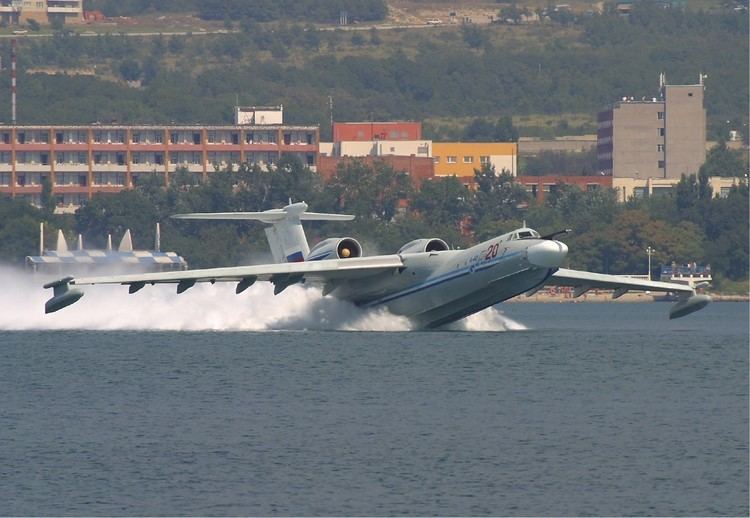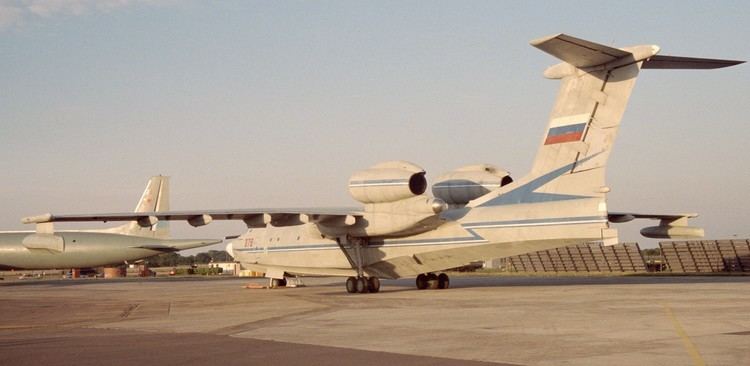Top speed 760 km/h Wingspan 42 m Manufacturer Beriev | Range 4,100 km Length 44 m First flight December 8, 1986 | |
 | ||
Beriev a 40 albatros be 42 nato code mermaid
The Beriev A-40 Albatros (also Be-42, NATO reporting name: Mermaid) was a jet-engined amphibious flying boat designed by the Beriev Aircraft Company for the anti-submarine warfare role. Intended as a replacement for the Beriev Be-12 amphibian and the land-based Ilyushin Il-38, the project was suspended after only one prototype had been manufactured, with second 70% completed, due to the breakup of the Soviet Union. The project was later revived and an order has been placed by the Russian Navy.
Contents
- Beriev a 40 albatros be 42 nato code mermaid
- Beriev a 40 albatros be 42 nato mermaid
- Development
- Design
- Operational history
- Variants
- Specifications A 40
- References

Beriev a 40 albatros be 42 nato mermaid
Development

The maiden flight was unplanned; during a high-speed taxi test, the airplane became airborne and ran out of runway, with the crew being forced to continue the takeoff. The subsequent flight and landing went without further incident, but the test crew were downgraded from their duties afterwards despite having saved the aircraft.

On 5 September 2008 the deputy commander of Russian Naval Aviation, Maj.Gen. Nikolai Kuklev, announced that the A-42 is to be adopted as a main SAR and antisubmarine aircraft of the Russian Navy, and a provisional contract for 4 SAR-outfitted aircraft has been awarded to the company, with deliveries to start in 2010. All four aircraft are expected to be in service by 2013. A contract to replace the aging fleet of Be-12 and Il-38 aircraft is under consideration.
Design

The A-40 was a jet-engined flying boat patrol bomber of all-metal construction with the engines located above the wing roots, atop each of the main landing gear nacelles at the rear of each wing root. The swept wings had a marked anhedral angle, with balance floats attached by short pylons directly under each wingtip.
Operational history
Between 1989 and 1998, the Beriev A-40 set 140 world records.
Variants
A-40
Initial ASW amphibian. 1 prototype built (second is 70% completed).A-40M
Projected upgrade to the initial version, utilising a new search and targeting system.A-40P

A-40PM (also known as Be-40P)

Be-40PT
A projected cargo/passenger version designed to carry 70 passengers, 10 tonnes (11 tons) of cargo or 37 passengers and up to 6.5 tonnes of cargo.A-42 (also known as Be-42)
A Search and rescue version designed to replace the Beriev Be-12PS, in response to the K-278 disaster. Construction of a prototype began, but was suspended in 1993. Studies are currently being made of a joint A-42/44 multi-role version, fitted with Progress D-27 propfans.A-44
Maritime patrol version designed in tandem with the A-42 before the projects were merged into a multi-role aircraft in 1993.A-42PE
Projected maritime patrol and SAR version intended for export. Powered by two Progress D-27 propfans.Specifications (A-40)
Data from Beriev's Jet Flying Boats
General characteristics
Performance
Armament
Projected Armament:
